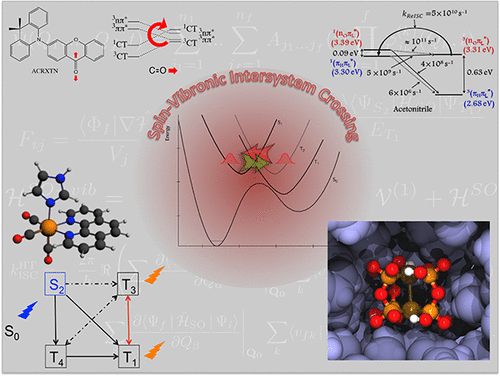当前位置:
X-MOL 学术
›
Chem. Rev.
›
论文详情
Our official English website, www.x-mol.net, welcomes your
feedback! (Note: you will need to create a separate account there.)
Spin-Vibronic Mechanism for Intersystem Crossing
Chemical Reviews ( IF 51.4 ) Pub Date : 2018-03-20 00:00:00 , DOI: 10.1021/acs.chemrev.7b00617 Thomas J. Penfold 1 , Etienne Gindensperger 2 , Chantal Daniel 2 , Christel M. Marian 3
Chemical Reviews ( IF 51.4 ) Pub Date : 2018-03-20 00:00:00 , DOI: 10.1021/acs.chemrev.7b00617 Thomas J. Penfold 1 , Etienne Gindensperger 2 , Chantal Daniel 2 , Christel M. Marian 3
Affiliation

|
Intersystem crossing (ISC), formally forbidden within nonrelativistic quantum theory, is the mechanism by which a molecule changes its spin state. It plays an important role in the excited state decay dynamics of many molecular systems and not just those containing heavy elements. In the simplest case, ISC is driven by direct spin–orbit coupling between two states of different multiplicities. This coupling is usually assumed to remain unchanged by vibrational motion. It is also often presumed that spin-allowed radiationless transitions, i.e. internal conversion, and the nonadiabatic coupling that drives them, can be considered separately from ISC and spin–orbit coupling owing to the vastly different time scales upon which these processes are assumed to occur. However, these assumptions are too restrictive. Indeed, the strong mixing brought about by the simultaneous presence of nonadiabatic and spin–orbit coupling means that often the spin, electronic, and vibrational dynamics cannot be described independently. Instead of considering a simple ladder of states, as depicted in a Jablonski diagram, one must consider the more complicated spin-vibronic levels. Despite the basic ideas being outlined in the 1960s, it is only with the advent of high-level theory and femtosecond spectroscopy that the importance of the spin-vibronic mechanism for ISC in both fundamental as well as applied research fields has been revealed with significant impact across chemistry, physics, and biology. In this review article, we present the theory and fundamental principles of the spin-vibronic mechanism for ISC. This is followed by empirical rules to estimate the rate of ISC within this regime. The most recent developments in experimental techniques, theoretical methods, and models for the spin-vibronic mechanism are discussed. These concepts are subsequently illustrated with examples, including the ISC mechanisms in transition metal complexes, small organic molecules, and organic chromophores.
中文翻译:

系统间交叉的自旋振动机理
非相对论量子理论中正式禁止的系统间交叉(ISC)是分子改变其自旋状态的机制。它在许多分子系统的激发态衰变动力学中起着重要作用,而不仅仅是那些含有重元素的系统。在最简单的情况下,ISC由具有不同多重性的两个状态之间的直接自旋轨道耦合驱动。通常认为该耦合通过振动运动保持不变。人们通常还认为,自转允许的无辐射跃迁,即内部转换以及驱动它们的非绝热耦合,可以与ISC和自旋-轨道耦合分开考虑,因为假定发生这些过程的时间尺度相差很大。但是,这些假设过于严格。确实,非绝热和自旋-轨道耦合同时存在带来的强烈混合意味着自旋,电子和振动动力学常常不能独立描述。与其考虑Jablonski图中描绘的状态的简单阶梯,不如考虑更复杂的自旋振子能级。尽管在1960年代概述了基本思想,但只有随着高级理论和飞秒光谱技术的出现,旋转振动机理对于ISC在基础研究领域和应用研究领域的重要性才被揭示出来,并产生了重大影响。涵盖化学,物理学和生物学。在这篇综述文章中,我们介绍了ISC自旋振动机理的理论和基本原理。接下来是经验法则,以估计该体制内ISC的发生率。讨论了自旋振动机理的实验技术,理论方法和模型的最新进展。这些概念随后将通过示例进行说明,包括过渡金属络合物,小的有机分子和有机发色团中的ISC机理。
更新日期:2018-03-20
中文翻译:

系统间交叉的自旋振动机理
非相对论量子理论中正式禁止的系统间交叉(ISC)是分子改变其自旋状态的机制。它在许多分子系统的激发态衰变动力学中起着重要作用,而不仅仅是那些含有重元素的系统。在最简单的情况下,ISC由具有不同多重性的两个状态之间的直接自旋轨道耦合驱动。通常认为该耦合通过振动运动保持不变。人们通常还认为,自转允许的无辐射跃迁,即内部转换以及驱动它们的非绝热耦合,可以与ISC和自旋-轨道耦合分开考虑,因为假定发生这些过程的时间尺度相差很大。但是,这些假设过于严格。确实,非绝热和自旋-轨道耦合同时存在带来的强烈混合意味着自旋,电子和振动动力学常常不能独立描述。与其考虑Jablonski图中描绘的状态的简单阶梯,不如考虑更复杂的自旋振子能级。尽管在1960年代概述了基本思想,但只有随着高级理论和飞秒光谱技术的出现,旋转振动机理对于ISC在基础研究领域和应用研究领域的重要性才被揭示出来,并产生了重大影响。涵盖化学,物理学和生物学。在这篇综述文章中,我们介绍了ISC自旋振动机理的理论和基本原理。接下来是经验法则,以估计该体制内ISC的发生率。讨论了自旋振动机理的实验技术,理论方法和模型的最新进展。这些概念随后将通过示例进行说明,包括过渡金属络合物,小的有机分子和有机发色团中的ISC机理。











































 京公网安备 11010802027423号
京公网安备 11010802027423号